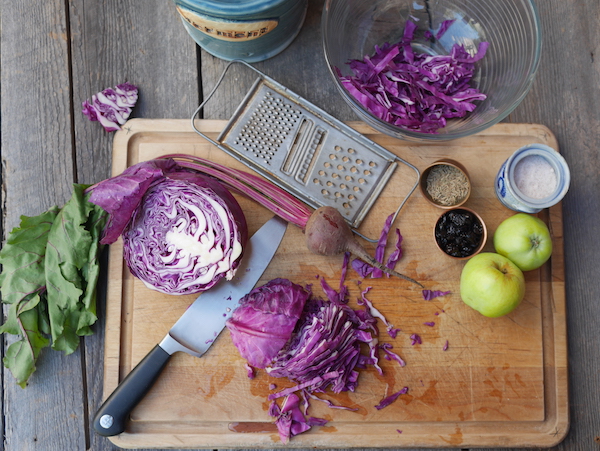Why this kraut? Crimson and earthy, sweet and sour…what’s not to love?
The color alone makes it worth making, and not only because it looks good on the plate. You may have heard the term “eat the rainbow”, and this ferment pulls from the red and purple vegetables. The quick story is, veggies with these colors contain flavonoids, lycopene, vitamin C and folate which are all important for general health and more specifically heart health. Anthocyanin is also in the mix which is thought to help prevent aging, especially when it comes to memory and our brain, as it has twice as much antioxidant power as vitamin C.
Probably the best thing about this kraut is that it is delicious. It wants to be tucked into a simple grilled cheddar cheese sandwich or served alongside a warm, winter pot roast. It is also a friendly ferment for those who may be a little, shall we say, kraut adverse. This sauerkraut not only has a mellow sour but also a nice sweetness as a result of the cranberries.
Ruby Red Kraut
Makes about a quart and a half
1 small red cabbage (about 1 ½ - 2 pounds), shredded
1 large beet, grated
1 crisp tart apple, cored, quartered and sliced thin
3 tablespoons, fruit-sweetened dried cranberries
1 tablespoon + ½ teaspoon salt
Optional: 2 teaspoons caraway seeds
Prepare the cabbage: remove the coarse outer leaves, rinse a few unblemished ones and set them aside. Rinse the rest of the cabbage in cold water. With a stainless-steel knife, quarter and core the cabbage. Thinly slice with the knife or a mandolin, then transfer the cabbage to a large bowl. Prepare the beet and apple and add to cabbage along with the dried cranberries and optional caraway seeds.
Add a tablespoon of the salt and, with your hands, massage it into the veggies, then taste. You should be able to taste the salt without it being overwhelming. Add more salt if necessary. Quickly the cabbage will glisten and liquid will begin to pool. If you’ve put in a good effort and don’t see much brine in the bowl, let it stand, covered, for 45 minutes, then massage again.
Transfer the cabbage a portion at a time to a ½ gallon jar, a small crock, or the fermenting system of your choice. Press down on each portion with your fist or a tamper. You should see some brine on top of the cabbage when you press. Weight down with fermentation weights or a simple bag trick. Set aside, somewhere nearby and out of direct sunlight for 10 - 14 days, or as long as 3 months - or until it achieves a flavor and sourness you enjoy.
The most important thing during the first few days is to make sure all the veggies are submerged and under the brine. Check daily in the beginning, pressing down as needed to allow the CO2 to escape and bring the brine back to the surface. Using a utensil, you can start to test the kraut in one week. You'll know it’s ready when:
· You will be able to smell that pickle-y smell
· It’s pleasingly sour-pickle-y tasting without the strong acidity of vinegar
· The veggies have softened a bit but retain some crunch.
This kraut will keep refrigerated for 1 year.



